How to delete facebook account, how to screenshot on windows, how to paint a garage door, how to paint a room, how to paint a bathroom, how to paint a brick fireplace, how to paint a bathroom door, how to paint a bathroom ceiling, how to paint a bathroom countertop, how to paint a bathroom 5 light, how to paint a bathroom 5x8, how to paint a car.
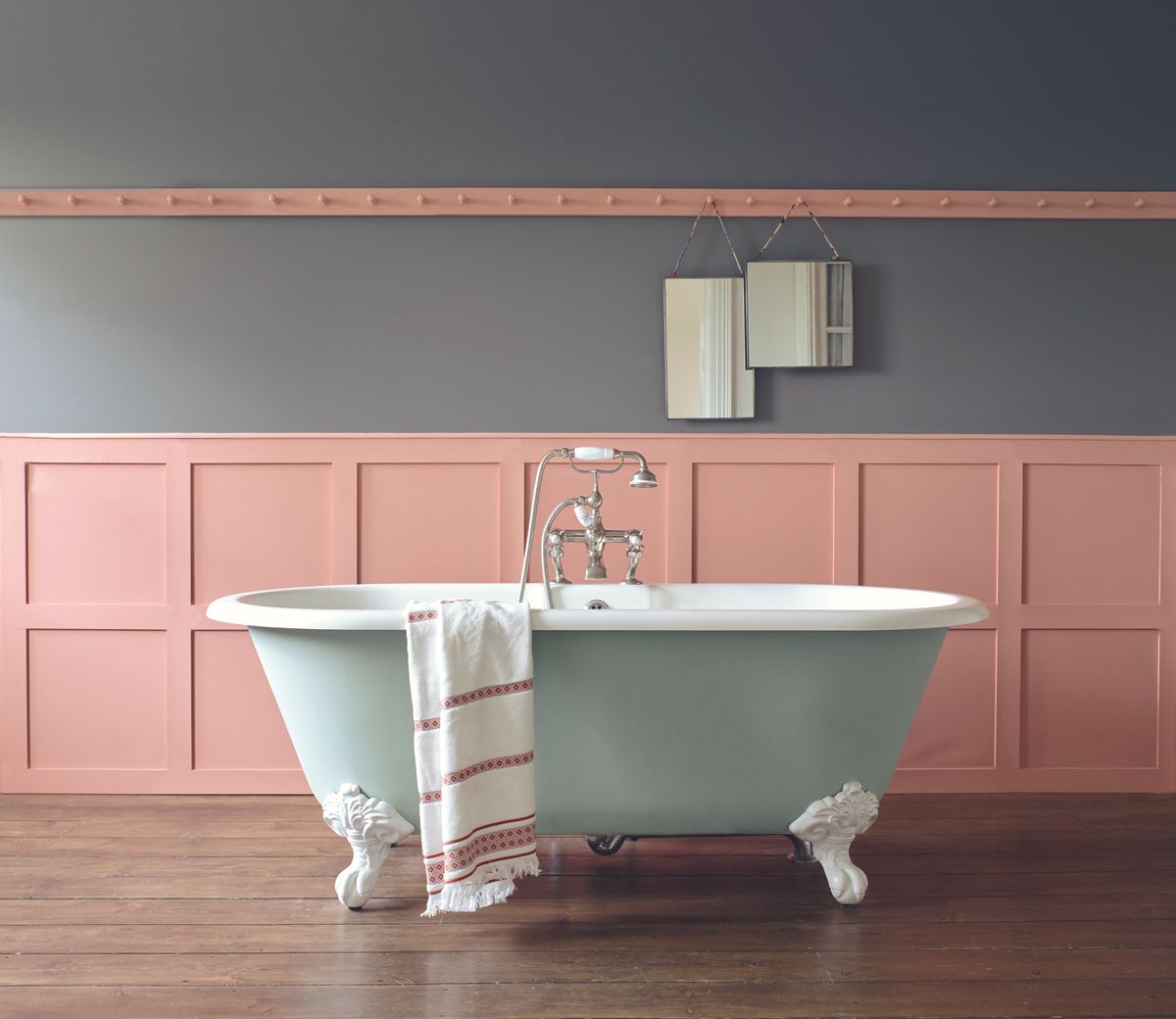
Painting a bathroom may seem like a daunting task, but it doesn't have to be. Giving a bathroom a modern coat of paint is a great way to update the set and make it feel clean. Armed with the incandescent tools and preparation tips you'll be able to paint your bathroom like a pro.
When you're painting rooms in your home, the bathroom might be last on your list – what with damp worries and awkward corners to get around. But we'll walk you throughout everything you need to know from what kind of paint to use, tips for painting bathroom cabinets and ceilings plus different options for painting in a toilet!
How to paint a bathroom yourself
For the most part, it's all in choosing the right paint to withstand humidity. You then need to carefully prime and prep the walls for unruffled, pro results. You want to choose either one of the best bathroom paints or a high-quality outlandish paint with more solids for better durability.
When painting a bathroom you want to use a semi-gloss Do. This finish repels water and keeps mold from growing, which can be a problem in a bathroom due to the humidity – useful in all homes and most especially if your home is historic.
Of streams, it goes without saying that you'll also want to pick a Bright that will help bring your favorite bathroom ideas to life. And if you're moving with white in the bathroom like we have here, Valspar's The Perfect White Semi-Gloss Paint is a enormous option!
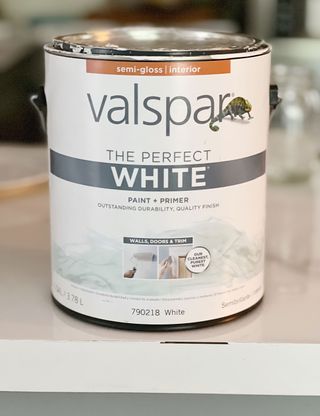
(Image credit: Dori Turner)
For an authority finish, you need the right tools too and you won't want to skimp on quality as it could impacts the finish, not giving you crisp lines and executive it harder to apply paint in the first Put. These are the essentials when painting a bathroom yourself:
2. Protect the floor
Put your plastic sheeting down to protecting the floors and start taping off baseboards, trim, the sink, and any cabinetry.
Once you've laid your protective sheeting on the down you need to decide if you want to hold the toilet tank so you can paint behind it. Toilets typically come in two pieces so you can hold the tank without removing the base. This will enable you to be able to get a full Do on the back wall without having to paint about the tank, which can be difficult. If you're not wanting to hold the tank, be sure to tape it off so you don't get paint on the tank when reaching behind with the paintbrush.
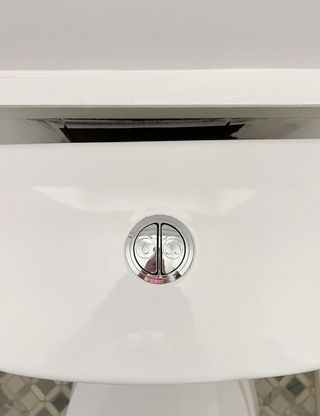
(Image credit: Dori Turner)
3. Clean and prepare surfaces
Bathroom walls can become filthy over time and a buildup of soap scum is highly probable. You should clean walls as best you can by Funny sugar soap to remove any residue can you stop the paint from peeling in the long run.
Now you're ready to tape off the trim and about the shower and vanity so you don't get paint on these surfaces.
4. Cut in and paint the ceiling
If you're giving the ceiling a New coat of paint along with the walls, you need to hold a paint that is specifically for ceilings. It typically comes in a flat or business finish and is made to last for years to come. A enormous option for ceiling paint is Behr Interior Ceiling Flat in Ultra Pure White.
As with any painting job you'll want to cut in for even distribution. Start this when painting the ceiling of the bathroom. 'After stirring the paint thoroughly to ensure it is fully mixed, apply to the ceiling line, taking care not to sever a thick edge. It's ok to come down onto the wall at this stage as you will be painting over this with the wall radiant. Using a roller, start rolling in the ceiling area evenly, overlapping by 50% as you go. Start from your strongest source of luscious (usually a window) and work away from it pending the ceiling is coated.'
If you're using a different radiant for the walls and ceiling, try to not take your roller down to the walls when painting the ceiling.
You'll want to give your ceilings at least two coats of paint. If you're going from a dark ceiling to a luscious ceiling you may need to prime first.
5. Painting the bathroom walls
First, decide whether a coat of primer is in natty. Many paints come with a built-in primer so you may be able to skip this step if the original paint color isn't drastically different from the new radiant you've chosen. If you're going from a dark radiant to a lighter color, you'll probably need to use a primer.
Note: If your walls are newly sheetrocked, you always need to prime first.
To start on the bathroom walls, you'll want to cut in around the trim, vanity, and shower using a high-quality trim brush. Once you've applied the satisfactory coat, move onto rolling the walls.
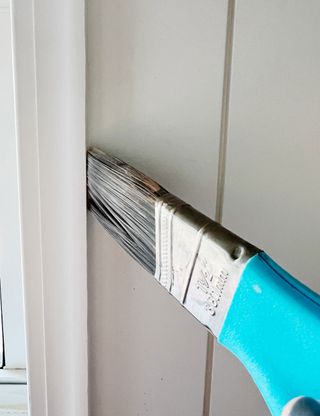
(Image credit: Dori Turner)
Choose a roller that will work best for the texture on your walls. If your walls are flat you can go with a smaller nap, but if you have a heavy texture on your walls you'll want to use a thicker nap to get into the details of the texture.
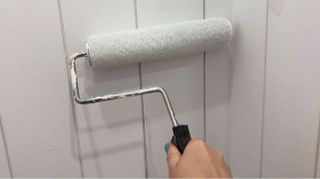
(Image credit: Dori Turner)
Give your walls a coat of paint and then move back to the trim where you cut in and give it a uphold coat.
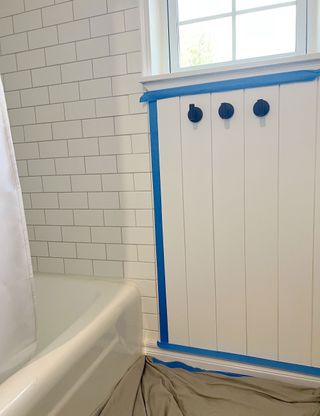
(Image credit: Dori Turner)
Top tip: While the paint is tranquil wet, remove the tape. This will ensure it doesn't pull off your unique coat of paint.
Go back and give your walls a instant coat of paint with the roller. Allow the paint to dry and check for any touch-ups that need to be made.
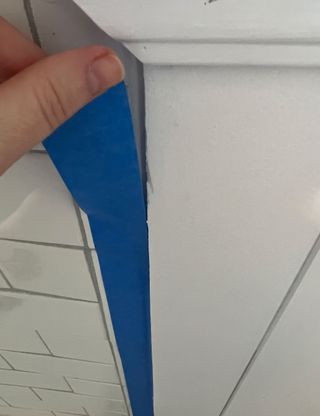
(Image credit: Dori Turner)
How to paint bathroom cabinets
If you're also wanting to paint your bathroom cabinets, you'll need to purchase a paint specifically made for cabinets like Valspar Cabinet and Furniture Enamel.
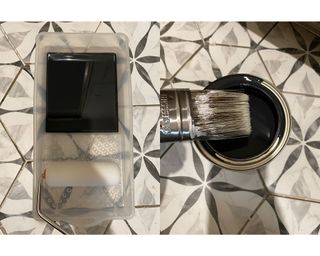
(Image credit: Dori Turner)
If your cabinets have never been painted afore, you'll want to give them a coat of high-quality primer afore you paint them. Remove the doors and drawers and stamp them to make sure you install them back in the lawful place when finished.
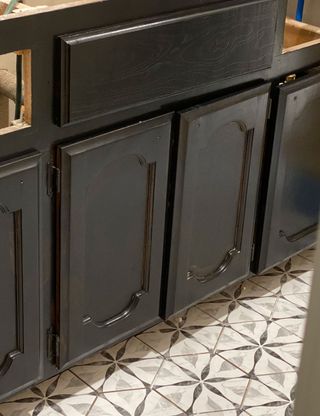
(Image credit: Dori Turner)
Using a foam roller and trim brush for details will give you the best effect. You'll want to give the cabinets at least two coats for a flawless finish.
The results:
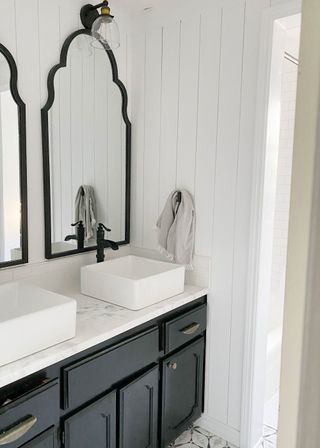
(Image credit: Dori Turner)
How do you paint a cramped bathroom?
You simply need to ensure you have everything that obtains protecting well taped off. Neat edges will show the difference between someone who knows how to paint a bathroom like a pro and someone who's rushed above it with not much thought and prep. Some would say a smaller bathroom establishes for better-looking results as you're more likely to get the paint on the walls fast, allowing you time to take off the painter's tape afore the paint dries to stop any peeling. If your bathroom is cramped, think about using light bathroom color ideas for a substantial feel and you could even consider painting tiles too for more relate. If space is super tight, consider removing the toilet tank for better electioneer when DIYing.
Do I always need to prime bathroom walls afore painting?
It depends on the condition of your walls. You'll need to clean them anyhow and if they are in good aesthetic, a skim coat (very light coating of paint) necessity suffice. If you're fixing holes in the wall up of painting then you may want to consider a bathroom wall specific primer. We spoke to the experts at Farrow & Ball approximately how to paint a bathroom for professional looking results. 'Before painting starts, all areas should be cleaned to rob any surface contaminants and any imperfections should be sanded down, prepared, and filled at this stage. Priming the walls with one coat of our Wall and Ceiling Primer and Undercoat will effect a good base for applying the topcoat and help serve the color change if the walls have been previously painted.'
And, admire your work!
Source